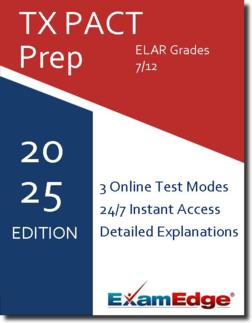TX PACT ELAR Grades 7/12 (731) Practice Tests & Test Prep by Exam Edge - Additional Information
Based on 22 Reviews
- Real Exam Simulation: Timed questions and matching content build comfort for your TX PACT ELAR Grades 7/12 test day.
- Instant, 24/7 Access: Web-based TX PACT English Language Arts and Reading Grades 7 to 12 practice exams with no software needed.
- Clear Explanations: Step-by-step answers and explanations for your TX PACT exam to strengthen understanding.
- Boosted Confidence: Reduces anxiety and improves test-taking skills to ace your TX PACT English Language Arts and Reading Grades 7 to 12 (731).



